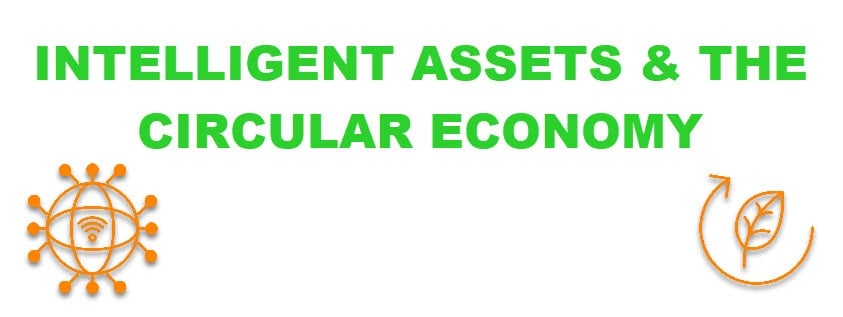Gartner predicts that more than 25 billion Internet of Things (IoT) devices by the end of 2021. In the industrial context, these IoT devices are collecting gigantic amounts of data that can be used to understand the condition of a machine or an asset in a factory. When combined with predictive models based on historical data, these assets become more “intelligent” with IoT.
“Intelligent Assets” are maintained proactively, are more productive, and therefore, have a long life! At the same time, we are also seeing a major shift globally from “Linear” models (build-use-dispose) to “Circular” models (extend-share-recycle). Fundamentally, intelligent assets can be used for longer in their initial target and adjacent industries. This is how they power the Circular Economy. In this article, we will explore the definition of intelligent assets and their deep link with the Circular Economy.
What are Circular Economy Principles ?
Before we dive in to circular economy principles, let’s briefly look at linear models and how they work.
What are Linear Models ?
Linear Models refer to the Build-Use-Dispose approach used by many industries ranging from plastic products, mobile phone to complex industrial assets.
The approach supports the prevailing business models where the customer has a transactional buy every X years type of approach that has its benefits:
- Frequent replacements result in multiple investments by the customers and higher revenues for the vendors
- The customer gets the latest technology e.g. the latest model of a machine offers higher throughput, the latest mobile phone takes better pictures etc.
- Tightly integrated products compel the customers to come back to the same vendor
What is the impact of Linear Models ?
However, the processes across design, manufacturing, and maintenance supporting this approach have their own side effects.
- A “blackbox” approach to product design might not encourage easy replacement
- Usage of proprietary parts might impact spare parts availability
- Specialized skills required for complex repairs might impact labor availability
In summary, the overall impact can be summarized as:
- Reduction in the overall lifespan of an asset
- Increased disposal rate leads to a higher carbon footprint
- Reduced business competitiveness in the long term
What is Circular Economy ? How does it work?
In contrast, Circular Models recommend the Extend-Share-Recycle approach where an asset’s life can be prolonged as much as possible (e.g. with predictive maintenance), it can be shared with other customers (e.g. telecom tower sharing) and be recycled for other use cases (e.g. using refurbishing & re-manufacturing).

In this cases, processes spanning design, manufacturing, maintenance and remanufacturing need to be design with circularity in mind. Modularity in design, predictive nature of the maintenance and reverse logistics play an important role in this.
In fact, a study done by the Ellen MacArthur Foundation finds that using circular processes, 45% reductions in carbon footprint and 90% reduction in wasted materials could be achieved.
What is Circular Business Models ?
In addition to contributing significantly to the sustainability goals, circularity also helps an organization re-look at its business model. Instead of selling products, they can sell a service e.g. compressed air instead of air conditioners. Intelligent Assets absolve the customers from the need to understand and maintain a vendor’s products. Instead, they just consume a service and the maintenance, repair, replacement etc. is handled by the vendor.

What are Intelligent Assets ?
Assets apply to both Business to Business (B2B) and Business to Consumer (B2C) companies. Broadly, they fall into two categories:
- Machines / equipment that help a manufacturer build products for his customers
- For example, assembly equipment in a manufacturing shop floor for Discrete industries
- Products that are purchased by customers that are pivotal to running their business
- For example, power generation turbines in the Utilities / Energy industries
Asset Maintenance
It is often the customer’s responsibility to maintain these assets in their premises by highly trained and experienced technicians.
- Maintenance strategies play a key role in reducing unplanned downtime and maximizing throughput
- Reactive maintenance (i.e. after the fault occurs) is often complemented with periodic preventive maintenance to achieve the desired results
- Optimization of other supply chain processes such as inventory management, warehousing and transportation in conjunction with maintenance is key
Making Assets “Intelligent”
With the proliferation of IoT and 5G connectivity, these assets are now able to communicate about their health e.g. temperature, vibrations etc. These apply to both Greenfield (new setup) and Brownfield (modernizing existing setup) scenarios in bridging the gap between operational and IT systems.
Large amounts of data generated at a factory / site level can be used to:
- Monitor status real-time
- Identify trends over time
- Predict failures
- Adapt maintenance strategy
When combined with the broader supply chain processes within the organization and beyond (supplier, logistics and asset networks), further efficiencies can be gained:
- Reduce on-boarding time
- Order spare parts / servicing in time
- Feedback loop between customers and manufacturers
Therefore, Intelligent Assets contribute heavily to an organization’s efforts to adopt circular business models. They are now able to directly associate their investments in “smartening” their assets with the impact on carbon footprint as well.
In the next article, we will explore how SAP Industry 4.Now solutions help customers realize their Intelligent Assets strategy.
